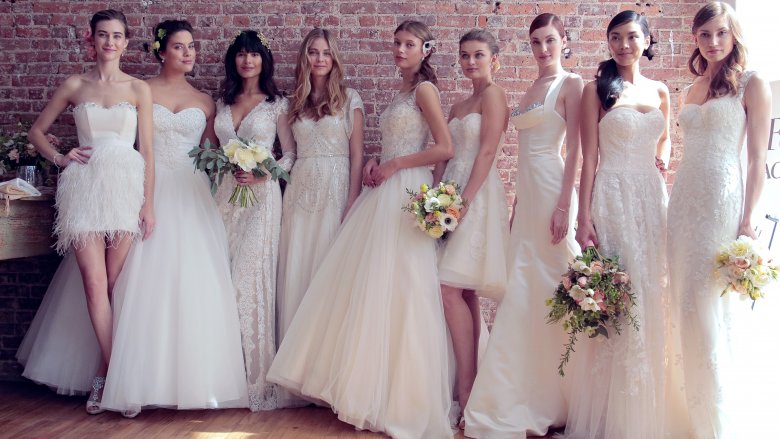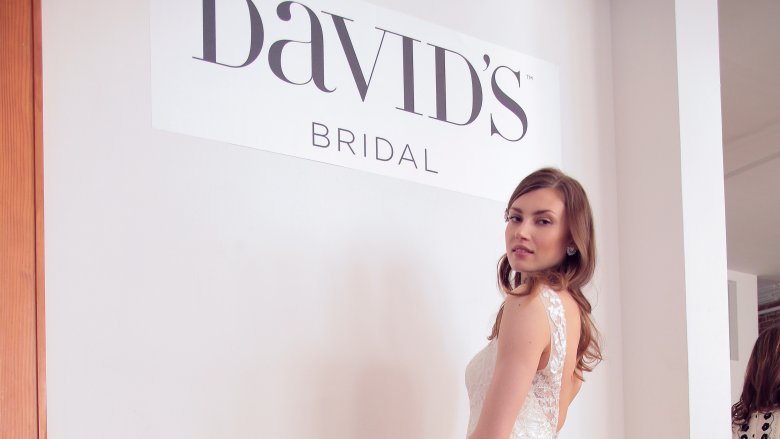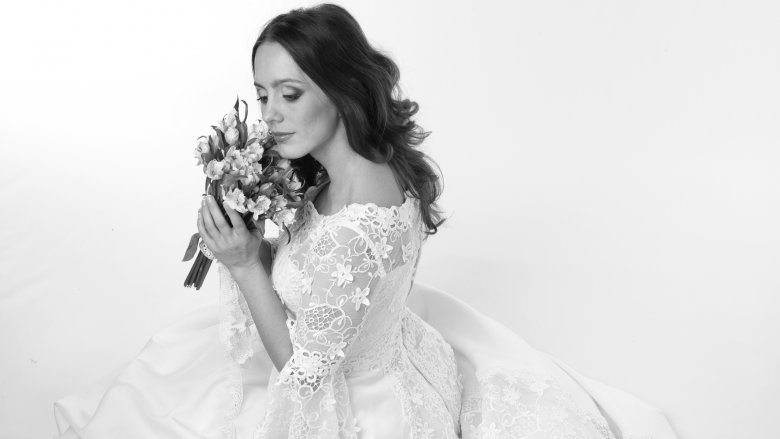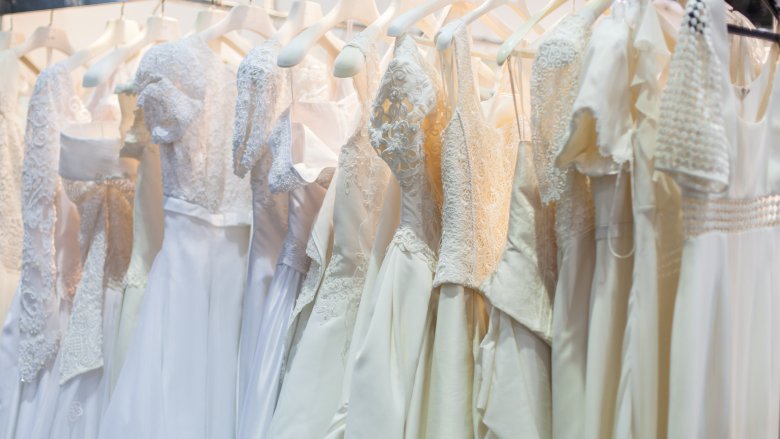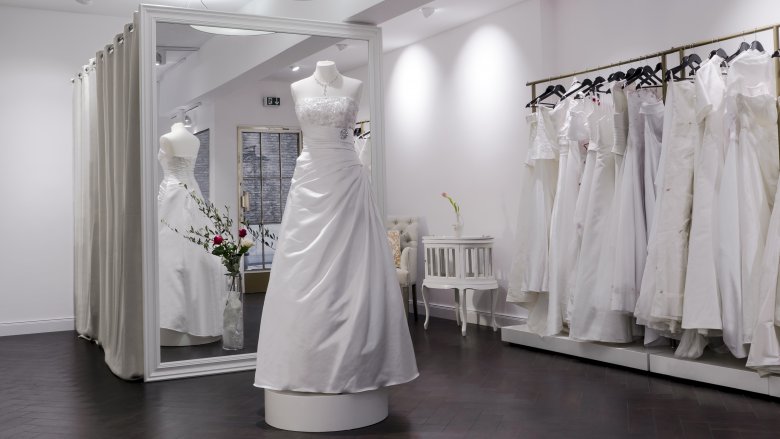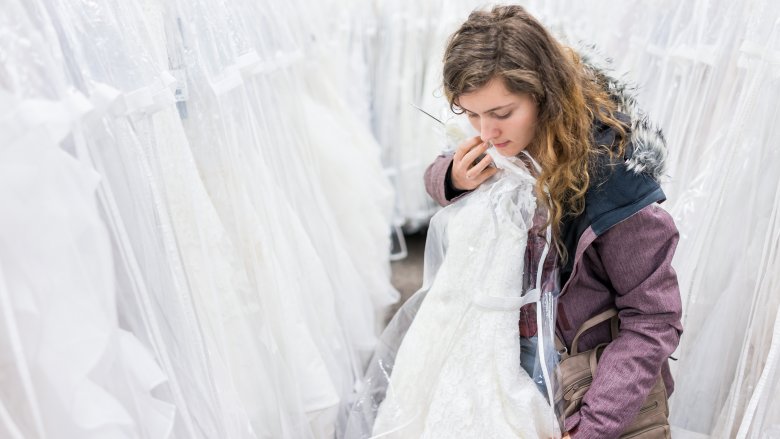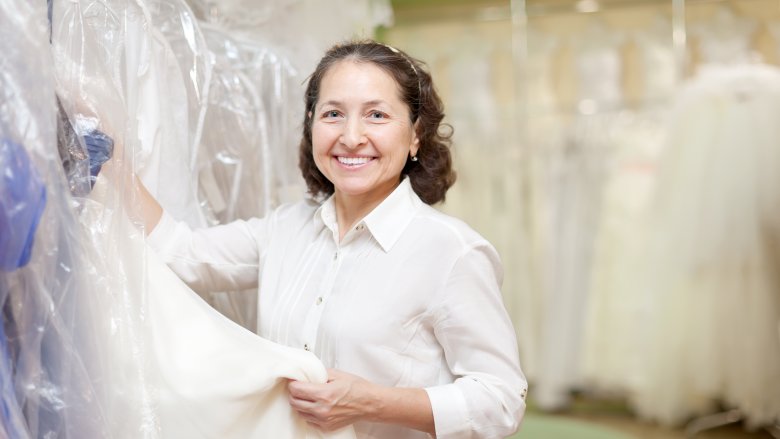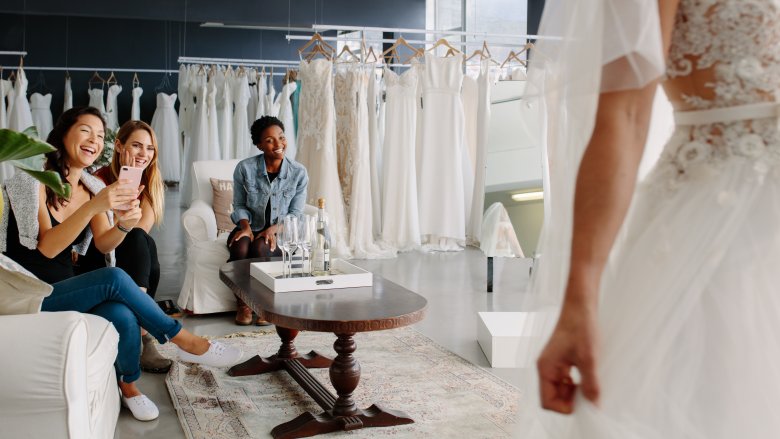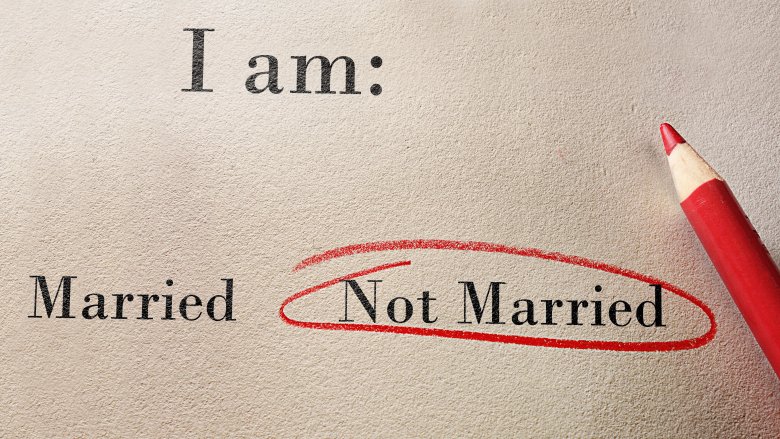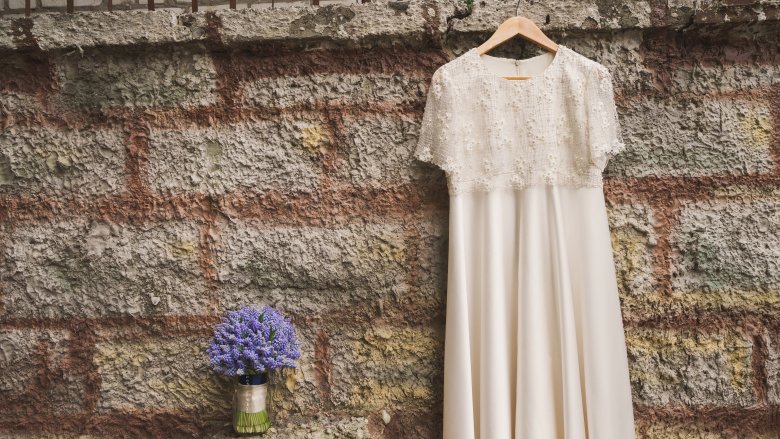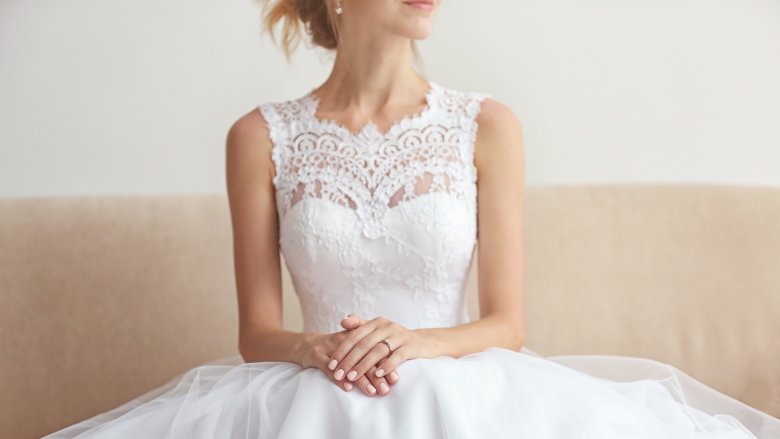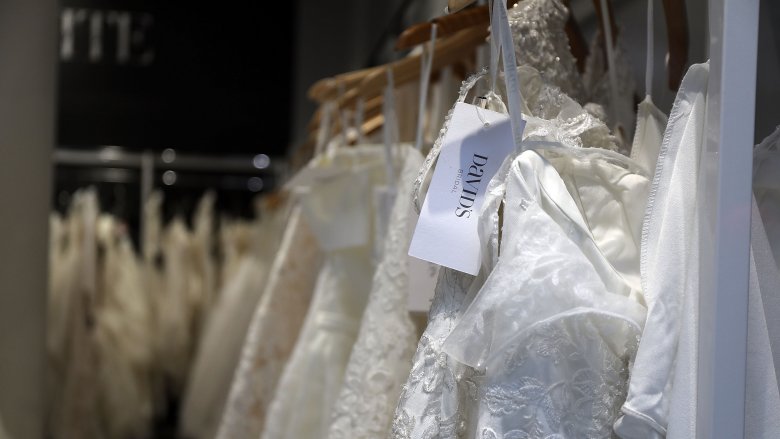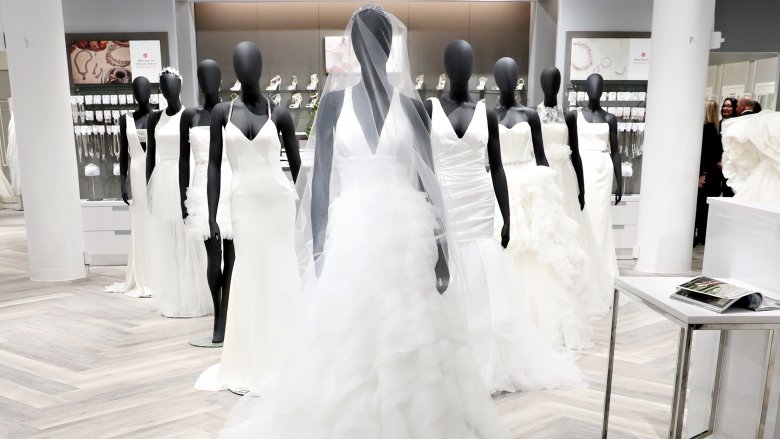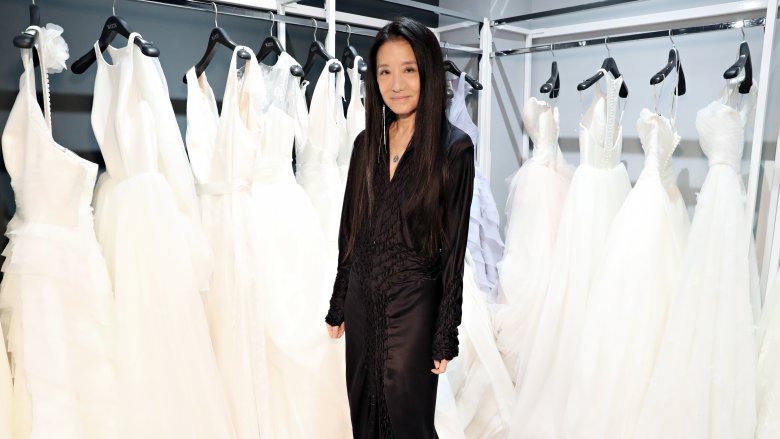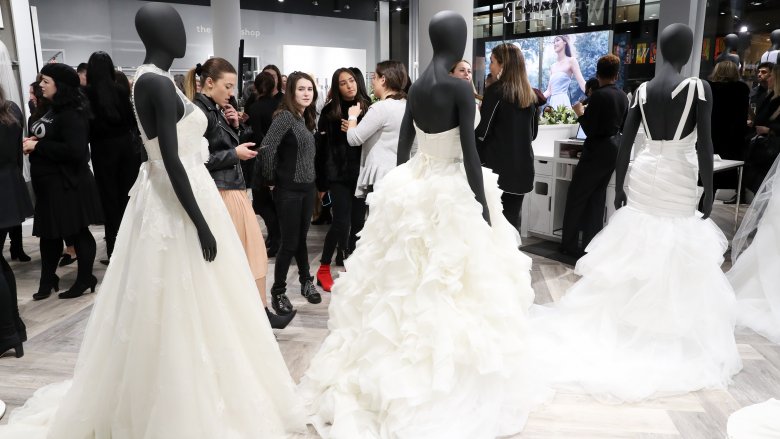The Untold Truth Of David's Bridal
Saying yes to the dress may be difficult, but picking the bridal shop is a process in and of itself. With options ranging from trunk shows to wedding dress warehouses, it can be a challenge to decide where to even start. Naturally, your budget also plays an important role in which dress — and shop — you select. This is where David's Bridal excels. Sometimes termed the "Walmart of bridal," David's Bridal has wedding gowns retailing for under $50 as of the writing of this article.
Whether you look to the wedding wear chain with a measure of disdain or are happy the super-store has such cheap prices, there's a lot more to this bridal empire than meets the eye. The true story of David's Bridal is one that not many know. From the company's grassroots beginning to the way they indefinitely altered the wedding dress industry, you may be surprised at the things you learn. Here's the untold truth of David's Bridal.
Who is David?
It may be hard to imagine, but David's Bridal was once nothing like the stores you see today. One of the few things that has remained the same is the company's name. One Perfect Day: The Selling of the American Wedding, a telling book by Rebecca Mead, details the start of the wedding wear empire.
In the early 1950s, a man by the name of David Reisberg opened his very first eponymous store, David's Bridal. For some two decades, Reisberg ran his one-off boutique. Although Reisberg seems to have led a fairly private and quiet life, his obituary from 2011 provides some insight into the ambitious life he lived.
Born David Milton Reisberg and originally from Pittsburgh, Pennsylvania, Reisberg was a veteran of World War II. At some point, Reisberg made the move to Fort Lauderdale, Florida, where he founded the very first David's Bridal location. In the 1970s, Reisberg sold his business and, instead of starting another shop, became a realtor — a position he held for some 30 years. In addition to his successful professional life, he was also a "devoted husband, father and grandfather," according to the Sun Sentinel (via Legacy).
From David's Bridal to Phil's
When Reisberg sold his business in the '70s, he probably couldn't have imagined what the future held. Nearly 50 years later, one in three brides would go on to wear wedding gowns purchased from David's Bridal. Although there would be no David's Bridal without David Reisberg, much of the company's success should be credited to the young man, entrepreneur Phil Youtie, who bought Reisberg's first store.
After purchasing the original David's Bridal salon in Fort Lauderdale, Florida, Youtie began buying out other bridal stores to the north and south of Fort Lauderdale — from Boca Raton to Coral Gables. Instead of changing the name from David's Bridal to Phil's, Youtie decided to keep the moniker Reisberg had chosen. However, once he started the task of converting acquired bridal salons into David's Bridal stores, it was very much Phil Youtie's brainchild. The small salon Reisberg had once owned quickly became a thing of the past.
Finding ways to undercut the competition
When Youtie took over David's Bridal and began expanding, his company wasn't all that different from other bridal salons throughout the country. According to One Perfect Day, they stocked gowns in one standard size as was the norm during that time.
By the 1980s, Youtie began experimenting with a different business model. He noticed that outlet malls that had once sold discontinued merchandise at a lower cost also started selling ready-to-wear clothing. In 1991, Youtie enlisted the help of his childhood buddy, Steve Erlbaum, and together they opened the first David's Bridal Warehouse in Hallandale, Florida. True to its name, it wasn't a glamorous location. There weren't any carpets on the floors nor any dressing rooms in which to try on gowns. What they did have, though, were bridal gowns at half the price other salons were charging. Youtie and his partner were able to offer these incredible prices by selling off manufacturers' overstocks.
"The first year, we made an enormous profit, because we had an unheard of markup," Youtie explained. The prices of the gowns may have been low, but everything else was extra. "We did no alterations, and if anyone needed a bobby pin, we would charge them for it," he said.
Here come the changes
When bridal manufacturers became aware of what David's Bridal was doing, you can imagine they were less than pleased. So much so that One Perfect Day revealed they started putting an end to selling their overstocks to the company. Not one to be deterred, Youtie turned to overseas manufacturers instead and negotiated with a Taiwanese company to make David's Bridal brand dresses.
Over the next nine years, Youtie also made some big changes to the warehouses themselves. Instead of the bare floors, he added carpeting. He also made the call to add fitting rooms. Gradually, the stark warehouses started resembling conventional stores, albeit much larger.
In 1999, Youtie, along with his childhood friend, decided to take their company public for a whopping $100 million. Just one year later, May Department Stores Company — the former parent company of Strawbridges and Famous-Barr — bought David's Bridal for $436 million. By the new millennium, David's Bridal was something entirely different than it'd been in its heyday.
Becoming a real threat to the bridal industry
While many brides were certainly benefiting from the extremely low prices of David's Bridal wedding wear, many independent bridal stores were beginning to suffer, The New Yorker reported. By 2003, David's Bridal had already dominated 20 percent of the bridal gown market in the United States and was showing no signs of slowing down. At that point in time, they had 181 stores and, as the first company to both mass-produce gowns and carry a full stock of ready-to-wear dresses in each of its stores, mom-and-pop shops were limited in what they could do to compete.
While some of the smaller indie wedding wear shops were carrying ready-made gowns, they still required tailoring. With tailoring, of course, meant the bride would need to come in for fittings. Add in time for alterations — not to mention the back-and-forth between the shop, the manufacturer, and the customer — and you're looking at about six months time and a pretty penny.
David's Bridal, on the other hand, stocked dresses from sizes 2 through 26 and the average wedding gown at David's Bridal was around $500, about $300 less than the national average of the time.
The billion dollar acquisition
While small and specialty bridal boutiques struggled to keep open their doors and attract customers, business only continued to boom for David's Bridal. In 2012, Clayton, Dubilier & Rice acquired David's Bridal, Inc., a news release published by David's Bridal confirmed. The company was, at that time, valued at slightly over $1 billion. Holy moly.
While there was likely no way for any small bridal retailer to beat the company's wedding gown prices, David's Bridal had made another move that was hard for anyone else to trump. The company began forming exclusive partnerships with well-known designers, like Vera Wang, to offer more affordable versions of designer wedding gowns.
The company also made the smart move to keep up with the times, using the internet to their advantage and quickly becoming one of the leading bridal websites. That's not to say they gave up on their brick-and-mortar locations, though. From 2003 to 2012, over a hundred new David's Bridal stores opened across the United States, with five branching into Canada.
Creating "a Disneyland experience for brides"
Just as Youtie had, Clayton, Dubilier & Rice started on reinventing David's Bridal right after their acquisition. Part of that plan involved hiring a new CEO, Pamela B. Wallack. Prior to her 2012 start at David's Bridal, Wallack was perhaps best known for her role at Gap, Inc., where she was president of Gap Kids, Baby Gap, and Gap Maternity for some ten years.
Wallack's first task upon being hired was to "do a lap" around one of the David's Bridal stores and assess how to improve the wedding dress shopping experience, she explained in an interview with Racked. "It felt like it was just waiting for someone to shine it up a little bit," she said. Wallack and her team set about making the store relevant again or, as she also put it, creating "a Disneyland experience for brides." She removed the plastic garment bags and let the dresses speak for themselves. She also invested in adding two additional sizes — 28 and 30 — and variations within those sizes.
Hiring Trevor Lunn also had a major impact on the brand — Lunn worked at Urban Outfitters Inc. for a decade, and is largely to thank for Anthropology's visual aesthetic as well as the development of the company's bridal branch, BHLDN. Lunn first order of business at David's Bridal was to tone down the bright fluorescent lighting and change the music to be more upbeat and mainstream, but that was only the beginning.
The fewer the weddings, the fewer the wedding dresses
Although David's Bridal may be responsible for styling one out of every three American brides, the number of weddings taking place each year are falling. In 2017, the amount of adults who never married reached an all-time high of 20 percent. According to data compiled by the United States Census Bureau from the same year, 55 percent of men and women aged 18 to 34 ranked getting married as "not important."
That's probably not the statistic bridal retailers want to hear. Even David's Bridal, who had been dominating the wedding market for years upon years, is not immune. Clayton, Dubilier & Rice may have had big plans for David's Bridal, but the chain had already peaked upon its acquisition in 2012, The Detroit News reported. Even with a new CEO and some pretty incredible changes, earnings declined some 30 percent in five short years. With the decline, came an avalanche of debt in an attempt to keep the company above water.
Unfortunately for David's Bridal, the math is pretty simple in this equation: You can't sell wedding gowns to people who don't need wedding gowns.
The problem with casual weddings
As if rapidly declining sales weren't bad enough, David's Bridal is also facing another problem. At the outset of 2018, Business Insider reported on a big change within the bridal industry. More and more brides began opting for casual wedding gowns. With H&M and other large, affordable stores creating their own bridal collections, the need for specialty bridal stores, like David's Bridal, is not as great.
"There are so many options for brides to shop now, and women have the option to shop for less," Anne Chertoff, a wedding-industry marketing consultant, explained to Business Insider, "The market is saturated."
In order to compete, even bigger changes would be required. "David's Bridal would need to continue making significant investments in digital capabilities and marketing in order to reverse its market share declines of the past several years," Raya Sokolyanska, a market analyst told investors (via Business Insider)."These investments are needed to attract the bride early in her online-first research process and then provide a seamless bricks-and-clicks shopping experience."
Of course, knowing what to do and actually doing it are two very different things.
Will David's Bridal live happily ever after?
By February 2018, Moody's Investor Service declared David's Bridal to have a "negative outlook." This was due, in part, to what Raya Sokolyanska called a "lack of meaningful improvement in operating performance in 2017, high leverage, and 2019 maturities." Basically, it's not looking good for David's Bridal. At all.
After some three years on the job, the Associated Press (via Seattle Times) reported that Pam Wallack, the CEO responsible for many of the changes David's Bridal still retains today, left the company. When Paul Pressler took her place, David's Bridal released a statement about his "extensive background in retail" and his "deep understanding of the brand." No doubt, the company was hoping to boost its sales. Unfortunately for the bridal chain, it didn't happen.
In the winter of 2018, David's Bridal brought on yet another new CEO, Scott Key, according to Bloomberg. They also hired restructuring advisers and legal counsel. It seems David's Bridal is not yet ready to call it quits — for better, for worse, for richer, for poorer.
Filing for bankruptcy, but it's "business as usual"
On a fateful Monday in November 2018, David's Bridal officially filed for Chapter 11 bankruptcy protection. It was no secret that the company was struggling and the decision to file would allow the bridal retailer to shed over $400 million in debt.
After filing for bankruptcy, many companies will close some of their locations in an effort to cut costs — but the bridal store chose not shutter their stores. Instead, David's Bridal CEO Scott Key revealed in a statement to CNBC that their "consensual restructuring plan" would not only allow them to reduce their debt but enable them to continue to run their "business as usual."
Their doors stayed open, current customers didn't have to fear losing their gowns, and new customers were more than welcome to place orders. "For more than 60 years, David's has delivered beautiful, high-quality dresses and accessories for our customers' most special occasions, and the actions we are taking will enable us to build on that tradition," Key assured the public.
Bouncing back after bankruptcy
David's Bridal must've set a New Year's resolution to get out from under bankruptcy. By the middle of January 2019, the company crushed that goal and successfully reduced its debt by around $450 million, as Los Angeles Times reported. It was of the utmost importance to CEO Scott Key to get rid of this debt — and to do so quickly. He told USA Today, "The news about David's entering bankruptcy — for some people that gets interpreted as 'David's is going away,' and that's clearly not the case."
Filing for Chapter 11 does not always lead to a company going out of business, but current and prospective clients who hear the term "bankrupt" would likely fear the worst. As Key admitted to Los Angeles Times, that's one of the reasons he wanted David's Bridal to bounce back so fast — and that's exactly what happened. In about two months' time, David's Bridal came out of bankruptcy "in a position of strength," according to Key. He further confirmed to Women's Wear Daily that David's Bridal is a "stronger company with significantly less debt."
From this day forward
David's Bridal may have emerged stronger from bankruptcy, but the company still has a long way to go. Regardless, CEO Scott Key seems determined. "We have been listening to feedback from our customers and have made a number of changes to better meet their needs," he confirmed to Women's Wear Daily. Indeed, the company is putting its money where its mouth is, as it were.
In an interview with USA Today in February 2019, Key revealed details about a new service involving a free "dedicated bridal stylist." He elaborated, saying, "We created the bridal stylist, which is the most experienced of the staff we have in stores, and then what we call a dress specialist, which handles the bridesmaids and special-occasion side of the business."
That's not all that's changed at David's Bridal. The CEO highlighted "a new line of product" as well as more availability in plus and petite sizes. The company also lowered the prices on some of their best-selling stuff and began hosting events with big names in the bridal industry, like Vera Wang. Now, that's pretty cool.
'Til death do us part
No matter how spectacular a bridal retailer may be, a company is likely not going to be able to sway the marriage rate in favor of more weddings. Nevertheless, David's Bridal is doing what it can with what it has. While the brand probably wouldn't complain if more people started getting hitched, the company knows there's still a market for wedding wear — both in store and online.
When speaking with USA Today, CEO Scott Key revealed that the company is "very focused on improving [their] digital customer experience and have a project going on that front." Key confirmed to Women's Wear Daily that the company launched BluePrint Registry, a free registry service. But David's Bridal refuses to believe brick-and-mortar stores are a thing of the past.
"If you look at market share today, the reality is that the majority of the units and the sales happen in physical retail locations," the CEO told USA Today. He continued, saying, "Think of online as the future and stores as the present." David's Bridal remains committed to selling both online and in-store; both now and later. 'Til death do us part and all that, right?
